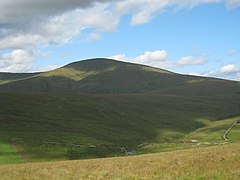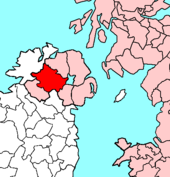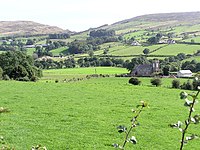Difference between revisions of "Tyrone"
| Line 2: | Line 2: | ||
|name=Tyrone | |name=Tyrone | ||
|map image=TyroneBrit4.PNG | |map image=TyroneBrit4.PNG | ||
| − | |picture= | + | |picture=Sawel mountain.jpg |
| − | |picture caption= | + | |picture caption=Sawel Mountain |
|area=1,260 square miles | |area=1,260 square miles | ||
|county town=[[Omagh]] | |county town=[[Omagh]] | ||
}} | }} | ||
| − | The '''County of Tyrone''' is a [[Counties of the United Kingdom|shire]]. | + | The '''County of Tyrone''' is a [[Counties of the United Kingdom|shire]] in Ulster. A large county though sparsely populated, it stretches from the border with [[County Donegal]] in the west, to the south-western shore of [[Lough Neagh]] in the east, bordering [[County Londonderry]] in the north and [[Fermanagh]] in the south. Within its 780,000 acres dwell 166,516 people. |
| − | {{ | + | The county town of Tyrone is [[Omagh]] in the midst of the shire. The [[county flower]] is bog-rosemary, which blooms in the peat bogs. |
| + | |||
| + | ==Geography== | ||
| + | [[File:Badoney Church and Barnes Gap - geograph.org.uk - 52793.jpg|left|thumb|200px|Barnes Gap, at Badoney]] | ||
| + | Tyrone is the largest county in Northern Ireland, spreading over 1,218 square miles of farm, moor and mountain. The length of the county, from the mouth of the River Blackwater at Lough Neagh to the western point near Carrickaduff Hill is 34 miles. The breadth, from the southern corner, southeast of [[Fivemiletown]], to the northeastern corner near [[Meenard Mountain]] is 23 miles. | ||
| + | |||
| + | The flat peatlands of eastern Tyrone border the shoreline of the largest lake in the British Isles, [[Lough Neagh]]. The land rises gradually across to the more mountainous terrain in the west of the county, the area surrounding the [[Sperrins|Sperrin Mountains]]. The highest point is [[Sawel Mountain]], standing at 2,224 feet. | ||
| + | |||
| + | The Sperrins dominate the interior of the county and though they spread across into Londonderry they are at their highest most spectacular here. The mountains have been designated Area of Outstanding Natural Beauty. | ||
| + | |||
| + | [[Annaghone]] claims to be the geographical centre of Northern Ireland. | ||
| + | |||
| + | ==Name== | ||
| + | The name ''Tyrone'' is derived from the Irish Gaelic ''Tír Eoghain'', meaning "Land of Eoghan". This Eoghan was, it is generally believed, ''Eógan mac Néill'', the son of king Niall of the Nine Hostages, and brother of [[Conall Gulban]], who gave his name to the kingdom of Tír Chonaill (Tyrconnell).<ref name="LI">{{cite web | title=Description of County Tyrone from ''Atlas and Cyclopedia of Ireland'' (1900) | work=Library Ireland| url=http://www.libraryireland.com/Atlas/Tyrone.php | accessdate=24 February 2009}}</ref> Historically it was anglicised as ''Tirowen'' or ''Tyrowen'', which are closer to the Irish pronunciation. | ||
| + | |||
| + | ==History== | ||
| + | [[File:Castlederg Castle - geograph.org.uk - 371758.jpg|right|thumb|Castlederg Castle ruins, on the site of an O'Neill stronghold]] | ||
| + | The historical land of ''Tír Eoghain'' stretched as far north as [[Lough Foyle]], and formed part of modern day [[County Londonderry]] east of the [[River Foyle]]. The majority of County Londonderry was carved out of Old Tyrone between 1610-1620 when that land was granted to the Guilds of London to as part of the Plantation of Ulster. | ||
| + | |||
| + | Tyrone was the traditional stronghold of the various O'Neill clans and families, the strongest of the Gaelic Irish families in [[Ulster]], surviving into the seventeenth century. The ancient principality of ''Tír Eoghain'', the inheritance of the O'Neills, included the whole of the present counties of Tyrone and Londonderry, and the four baronies of [[West Inishowen]], [[East Inishowen]], [[Raphoe North]] and [[Raphoe South]] in [[County Donegal]].<ref name="LI"/> | ||
| + | |||
| + | Tyrone was one of the officially planted counties in the seventeenth century Plantation of Ulster. | ||
| + | |||
| + | ==Towns and villages== | ||
| + | Omagh, the county town, is the county's only sizable town. | ||
| + | |||
| + | ===Towns=== | ||
| + | [[File:Omagh view (02), January 2010.JPG|right|thumb|200px|Omagh]] | ||
| + | *[[Coalisland]] | ||
| + | *[[Cookstown]] | ||
| + | *[[Dungannon]] | ||
| + | *[[Omagh]] | ||
| + | *[[Strabane]] | ||
| + | |||
| + | ===Villages=== | ||
| + | *[[Ardboe]] | ||
| + | *[[Carrickmore]] | ||
| + | *[[Castlederg]] | ||
| + | *[[Dromore, Tyrone|Dromore]] | ||
| + | *[[Fintona]] | ||
| + | *[[Fivemiletown]] | ||
| + | *[[Moy, Tyrone|Moy]] | ||
| + | *[[Newtownstewart]] | ||
| + | *[[Sion Mills]] | ||
| + | |||
| + | ==Baronies== | ||
| + | *[[Clogher (barony)|Clogher]] | ||
| + | *[[Dungannon Lower]] | ||
| + | *[[Dungannon Middle]] | ||
| + | *[[Dungannon Upper]] | ||
| + | *[[Omagh East]] | ||
| + | *[[Omagh West]] | ||
| + | *[[Strabane Lower]] | ||
| + | *[[Strabane Upper]] | ||
| + | |||
| + | ==References== | ||
| + | {{Reflist}} | ||
| + | * ''The Memoirs of John M. Regan, a Catholic Officer in the RIC and RUC, 1909–48'', Joost Augusteijn, editor, District Inspector, Co. Tyrone, 1920s, ISBN 978-1-84682-069-4. | ||
| + | |||
| + | ==Books== | ||
| + | *McNeill, I. 2010. ''The Flora of County Tyrone''. National Museums of Northern Ireland. ISBN 978-905989-17-1 | ||
| + | |||
| + | ==Outside links== | ||
| + | *{{dmoz|Regional/Europe/United_Kingdom/Northern_Ireland/Tyrone}} | ||
| + | *[http://www.flavouroftyrone.com/ A Flavour of Tyrone] | ||
| + | *[http://www.countytyrone.com/ County Tyrone.com] | ||
| + | *[http://www.nmni.com/uafp/About-Us Ulster-American Folk Park] | ||
{{British county}} | {{British county}} | ||
Revision as of 12:59, 26 April 2011
| Tyrone United Kingdom | |
 Sawel Mountain | |
|---|---|

| |
| [Interactive map] | |
| Area: | 1,260 square miles |
| Population: | 178,440 |
| County seat: | Omagh |
| County flower: | Bog-rosemary [1] |
The County of Tyrone is a shire in Ulster. A large county though sparsely populated, it stretches from the border with County Donegal in the west, to the south-western shore of Lough Neagh in the east, bordering County Londonderry in the north and Fermanagh in the south. Within its 780,000 acres dwell 166,516 people.
The county town of Tyrone is Omagh in the midst of the shire. The county flower is bog-rosemary, which blooms in the peat bogs.
Contents
Geography
Tyrone is the largest county in Northern Ireland, spreading over 1,218 square miles of farm, moor and mountain. The length of the county, from the mouth of the River Blackwater at Lough Neagh to the western point near Carrickaduff Hill is 34 miles. The breadth, from the southern corner, southeast of Fivemiletown, to the northeastern corner near Meenard Mountain is 23 miles.
The flat peatlands of eastern Tyrone border the shoreline of the largest lake in the British Isles, Lough Neagh. The land rises gradually across to the more mountainous terrain in the west of the county, the area surrounding the Sperrin Mountains. The highest point is Sawel Mountain, standing at 2,224 feet.
The Sperrins dominate the interior of the county and though they spread across into Londonderry they are at their highest most spectacular here. The mountains have been designated Area of Outstanding Natural Beauty.
Annaghone claims to be the geographical centre of Northern Ireland.
Name
The name Tyrone is derived from the Irish Gaelic Tír Eoghain, meaning "Land of Eoghan". This Eoghan was, it is generally believed, Eógan mac Néill, the son of king Niall of the Nine Hostages, and brother of Conall Gulban, who gave his name to the kingdom of Tír Chonaill (Tyrconnell).[1] Historically it was anglicised as Tirowen or Tyrowen, which are closer to the Irish pronunciation.
History
The historical land of Tír Eoghain stretched as far north as Lough Foyle, and formed part of modern day County Londonderry east of the River Foyle. The majority of County Londonderry was carved out of Old Tyrone between 1610-1620 when that land was granted to the Guilds of London to as part of the Plantation of Ulster.
Tyrone was the traditional stronghold of the various O'Neill clans and families, the strongest of the Gaelic Irish families in Ulster, surviving into the seventeenth century. The ancient principality of Tír Eoghain, the inheritance of the O'Neills, included the whole of the present counties of Tyrone and Londonderry, and the four baronies of West Inishowen, East Inishowen, Raphoe North and Raphoe South in County Donegal.[1]
Tyrone was one of the officially planted counties in the seventeenth century Plantation of Ulster.
Towns and villages
Omagh, the county town, is the county's only sizable town.
Towns
Villages
Baronies
- Clogher
- Dungannon Lower
- Dungannon Middle
- Dungannon Upper
- Omagh East
- Omagh West
- Strabane Lower
- Strabane Upper
References
- ↑ 1.0 1.1 "Description of County Tyrone from Atlas and Cyclopedia of Ireland (1900)". Library Ireland. http://www.libraryireland.com/Atlas/Tyrone.php. Retrieved 24 February 2009.
- The Memoirs of John M. Regan, a Catholic Officer in the RIC and RUC, 1909–48, Joost Augusteijn, editor, District Inspector, Co. Tyrone, 1920s, ISBN 978-1-84682-069-4.
Books
- McNeill, I. 2010. The Flora of County Tyrone. National Museums of Northern Ireland. ISBN 978-905989-17-1
Outside links
- Tyrone at the Open Directory Project
- A Flavour of Tyrone
- County Tyrone.com
- Ulster-American Folk Park
| Counties of the United Kingdom |
|---|
|
Aberdeen • Anglesey • Angus • Antrim • Argyll • Armagh • Ayr • Banff • Bedford • Berks • Berwick • Brecknock • Buckingham • Bute • Caernarfon • Caithness • Cambridge • Cardigan • Carmarthen • Chester • Clackmannan • Cornwall • Cromarty • Cumberland • Denbigh • Derby • Devon • Dorset • Down • Dumfries • Dunbarton • Durham • East Lothian • Essex • Fermanagh • Fife • Flint • Glamorgan • Gloucester • Hants • Hereford • Hertford • Huntingdon • Inverness • Kent • Kincardine • Kinross • Kirkcudbright • Lanark • Lancaster • Leicester • Lincoln • Londonderry • Merioneth • Middlesex • Midlothian • Monmouth • Montgomery • Moray • Nairn • Norfolk • Northampton • Northumberland • Nottingham • Orkney • Oxford • Peebles • Pembroke • Perth • Radnor • Renfrew • Ross • Roxburgh • Rutland • Selkirk • Shetland • Salop • Somerset • Stafford • Stirling • Suffolk • Surrey • Sussex • Sutherland • Tyrone • Warwick • West Lothian • Westmorland • Wigtown • Wilts • Worcester • York |


